Types of English Language Proficiency Tests in Malaysia
January 22, 2024
Nurbek J

In Malaysia, various English language proficiency tests are available to assess and certify students' English linguistic capabilities, opening a world of job opportunities and helping you connect personally and culturally with others.
Having a good English Proficiency Test (EPT) score proves that you:
1. Have a strong command of the English language
A good score demonstrates your ability to communicate effectively in English, showcasing your proficiency in reading, writing, speaking, and listening skills.
2. Enhance your academic prospects
A high score can significantly improve your chances of admission to prestigious universities and colleges where English proficiency is required. It shows that you can study and engage with academic materials in English.
3. Increase employability in the global job market
In today's interconnected world, many employers require employees who can communicate proficiently in English. A good score reflects your language skills and can enhance your employability across various industries and professions.
4. Facilitate migration and visa applications
If you plan to migrate to an English-speaking country, a good score can greatly enhance your chances of obtaining a visa. Immigration authorities often require proof of English language proficiency, and a high score can strengthen your application.
5. Gain confidence in your language abilities
Achieving a good score can boost your confidence in using English in various situations. It demonstrates your ability to express yourself effectively, understand complex ideas, and engage in meaningful conversations, leading to greater self-assurance in both academic and social contexts.
6. Stand out among other candidates
A good score can give you an edge over other candidates in competitive settings, such as scholarship applications or job interviews. It showcases your dedication to language learning and highlights your commitment to personal and professional growth.
Remember, a good EPT score is not only a testament to your language skills but also a valuable asset that can open doors to exciting opportunities in education, career, and personal development.
This comprehensive guide provides detailed information about the different types of English language proficiency tests currently conducted in Malaysia, highlighting their content, structure, and grading system.
All Tests Mentioned (in order):
- Malaysian University English Test (MUET)
- International English Language Testing System (IELTS)
- Test of English as a Foreign Language (TOEFL)
- Pearson Test of English Academic (PTE Academic)
- Cambridge Assessment English (CAE)
- All Test Fees
1. Malaysian University English Test (MUET)
The Malaysian University English Test (MUET) is primarily taken by students who intend to pursue first-degree studies within the field of English.
MUET assesses students' English language proficiency in four components:
- Listening
- Speaking
- Reading
- Writing
Assessing candidates’ level of proficiency using aggregated scores ranging from 1 to 360, which correspond to Bands from 1 to 5+.
The test strongly emphasises critical thinking, academic writing, and the ability to communicate effectively in English. It ensures students possess the necessary language skills to succeed in their tertiary education.
*MUET scores are often used as a requirement for admission into Malaysian and selected Singaporean universities*
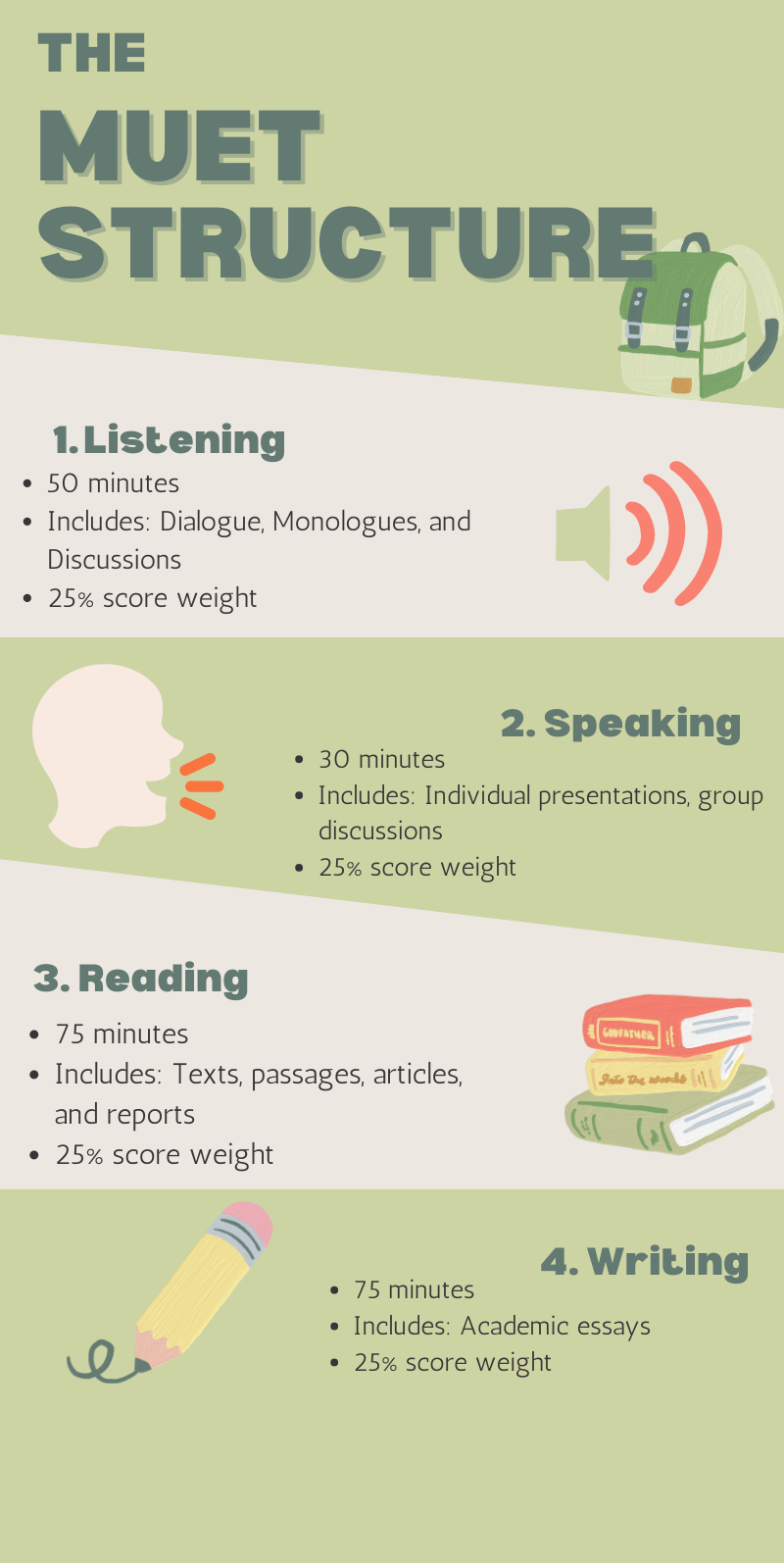
Aggregated scores:
| AGGREGATED SCORE | BAND | USER |
| 331 - 360 | 5+ | Proficient |
| 294 - 330 | 5 | Proficient |
| 258 - 293 | 4.5 | Independent |
| 211 - 257 | 4 | Independent |
| 164 - 210 | 3.5 | Independent |
| 123 - 163 | 3 | Independent |
| 82 - 122 | 2.5 | Basic |
| 36 - 81 | 2 | Basic |
| 1 - 35 | 1.5 | Basic |
2. International English Language Testing System (IELTS)
IELTS is a globally recognised English language proficiency test accepted by universities and organisations worldwide. It evaluates the language skills of non-native English speakers, measuring their proficiency in four sections:
- Listening
- Reading
- Writing
- Speaking
*The IELTS Academic module is suitable for high school students planning to study abroad, while IELTS General Training is designed for those seeking immigration or work opportunities in English-speaking countries*

The IELTS doesn’t use a percentage or specific point system. Instead, it uses a nine-band scoring system to evaluate its test takers, with each module being sorted into bands corresponding to a specific level of English proficiency, ranging from 1 (nonuser) to 9 (expert user).
The overall band score results from the average of the 4 scores rounded to the nearest whole or half band (i.e. scores ending in .25 rounded up to the next half band and scores ending in .75 rounded up to the next whole band).
Example of rounding:
- If your overall score is an average of 5.86, your score will increase to a 6
- If your overall score is an average of 5.1, your score will decrease to a 5
- If your overall score is an average of 5.25, your score will increase to a 5.5
Example of overall calculation:
| Reading | 6 |
| Writing | 5 |
| Listening | 5.5 |
| Speaking | 6 |
| Average of all four skills | 5.6 |
| Overall score | 6 |
IELTS Band Description:
| BAND SCORE | SKILL LEVEL | DESCRIPTION |
| 9 | Expert user |
|
| 8 | Very good user |
|
| 7 | Good user |
|
| 6 | Competent user |
|
| 5 | Modest user |
|
| 4 | Limited user |
|
| 3 | Extremely limited user |
|
| 2 | Intermittent user |
|
| 1 | Non-user |
|
| 0 | Did not attempt the test |
|
IELTS Listening Scores:
| NUMBER OF CORRECT ANSWERS | BAND SCORES |
| 39-40 | 9 |
| 37-38 | 8.5 |
| 35-36 | 8 |
| 32-34 | 7.5 |
| 30-31 | 7 |
| 26-29 | 6.5 |
| 23-25 | 6 |
| 18-22 | 5.5 |
| 16-17 | 5 |
| 13-15 | 4.5 |
| 11-12 | 4 |
IELTS Reading Scores:
| NUMBER OF CORRECT ANSWERS | BAND SCORES |
| 40-39 | 9 |
| 38-37 | 8.5 |
| 36-35 | 8 |
| 34-33 | 7.5 |
| 32-30 | 7 |
| 29-27 | 6.5 |
| 26-23 | 6 |
| 22-19 | 5.5 |
| 18-15 | 5 |
| 14-13 | 4.5 |
| 12-10 | 4 |
| 9-8 | 3.5 |
| 7-6 | 3 |
| 5-4 | 2.5 |
IELTS Writing Test Assessment Criteria:
Writing tasks 1 and 2 are monitored on 4 parameters. Examiners award a band score for each of the following criteria:
- Task Achievement (Task 1)
- Task Response (for Task 2)
- Coherence and Cohesion
- Lexical Resource
- Grammatical Range and Accuracy
| Task Achievement (for Task 1) |
|
| Task Response (for Task 2) |
|
| Coherence and Cohesion |
|
| Lexical Resource |
|
| Grammatical Range and Accuracy |
|
IELTS Speaking Test Assessment Criteria
Examiners award a band score for each of the four criteria:
- Fluency and Coherence
- Lexical Resource
- Grammatical Range and Accuracy
- Pronunciation
The four criteria are weighted equally.
| Fluency and Coherence |
|
| Lexical Resource |
|
| Grammatical Range and Accuracy |
|
| Pronunciation |
|
3. Test of English as a Foreign Language (TOEFL)
TOEFL is another widely accepted English language proficiency test for academic purposes.
It measures English language skills in four areas:
- Reading
- Listening
- Speaking
- Writing
TOEFL is recognised by universities globally, including those in Malaysia.
*The test evaluates students' ability to understand and use English in an academic setting, making it an ideal choice for high school students aiming to study abroad*
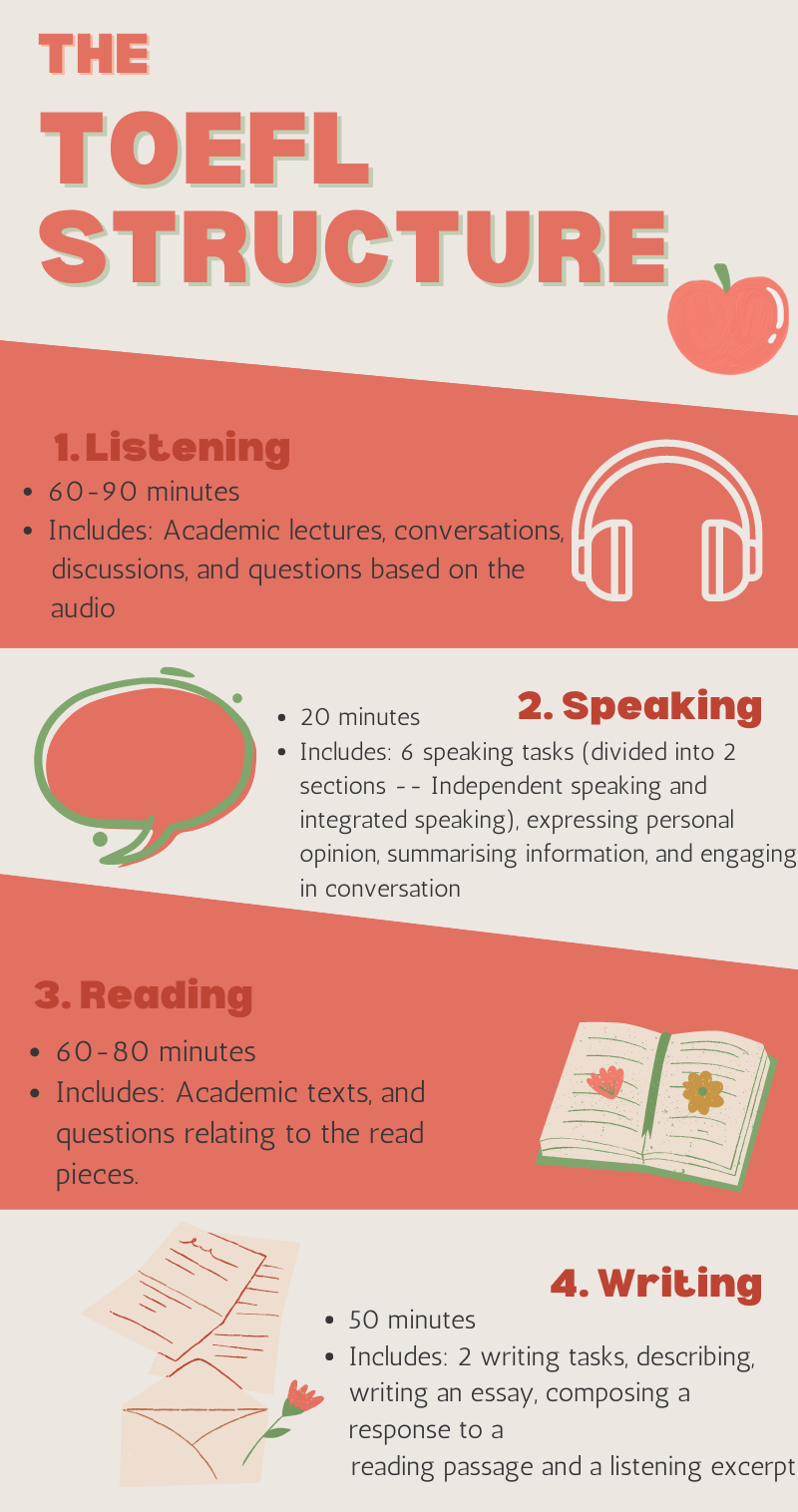
Raw vs Scaled scores
Raw score - Your raw score is the number of correct answers you have given on any of the given sections (listening, reading, writing, and speaking).
*However, since the number of questions differs between sections, your raw score must be scaled*
Scared score - Your scaled score is your raw score on a 0-30 point system that TOEFL uses to mark your results on the report card.
TOEFL Scoring System
Reading and Listening Section:
- Each question is worth 1 point.
- The number of correct answers is tallied to obtain a raw score.
- The raw score is then converted to a scaled score.
Speaking and Writing Section:
- Both human raters and an automated scoring system evaluate the Speaking section.
- Human raters assess the test-taker's responses based on rubrics provided by ETS (Educational Testing Service).
- The raters assign scores of 0 to 4 for each task. *Speaking.
- The raters assign scores of 0 to 5 for each task. *Writing.
- The scores given by the human raters are combined with scores generated by the automated scoring system.
- The combined scores are then converted to a scaled score ranging from 0 to 30 using a conversion chart provided by ETS.
4. Pearson Test of English Academic (PTE Academic)
PTE Academic is a computer-based English language proficiency test that assesses the candidate’s skills in:
- Listening
- Reading
- Speaking
- Writing
The Pearson Test is accepted by universities and colleges worldwide, including several institutions in Malaysia.
*PTE Academic evaluates real-life English skills, focusing on academic and general language use. Making it an ideal test for students who wish to study or immigrate to an English language-dominated country*
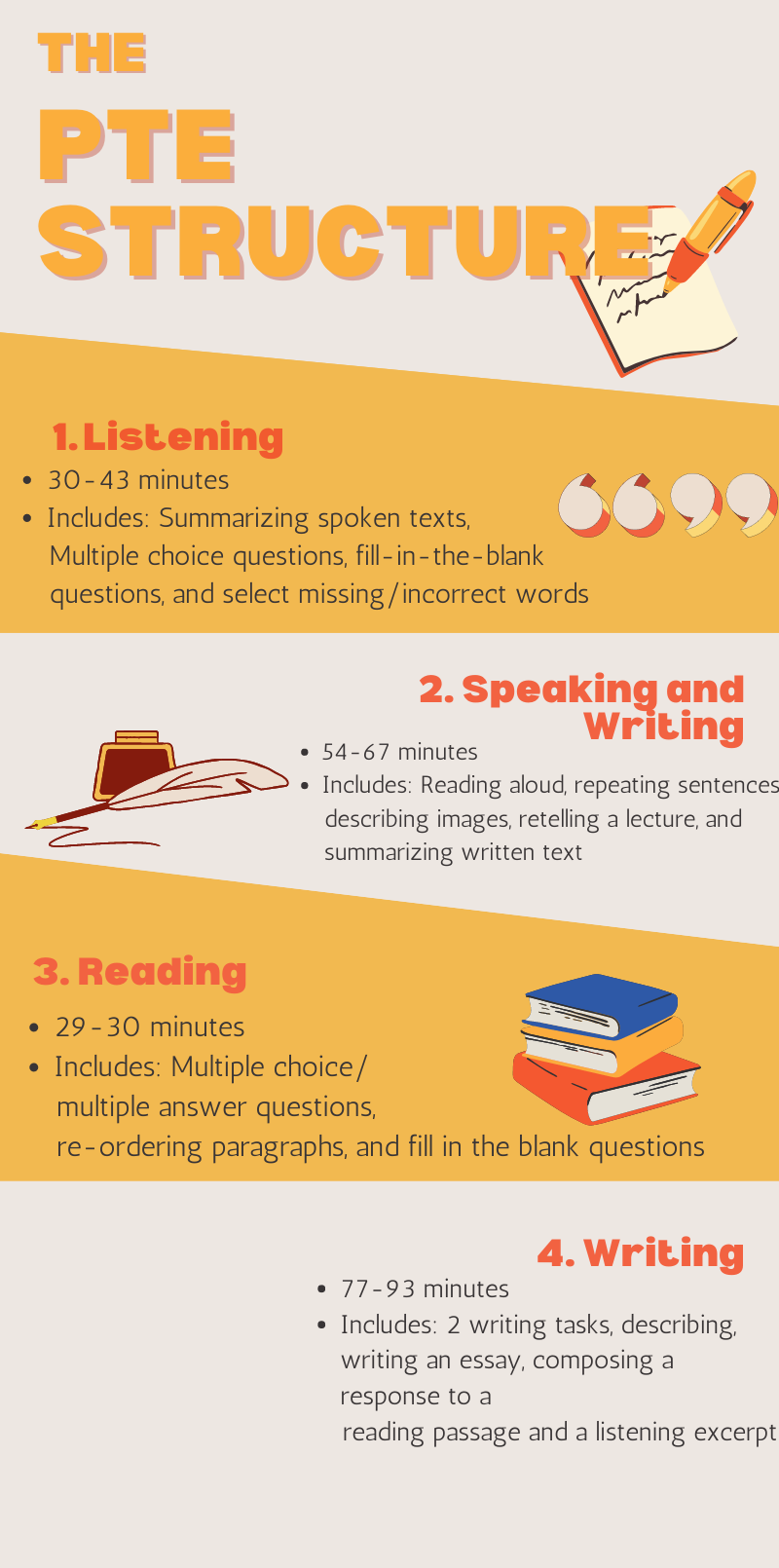
Upon completing a PTE Academic test, you will receive a Score Report and a Skills Profile to assist in understanding your test score, language skill level, and areas of improvement.
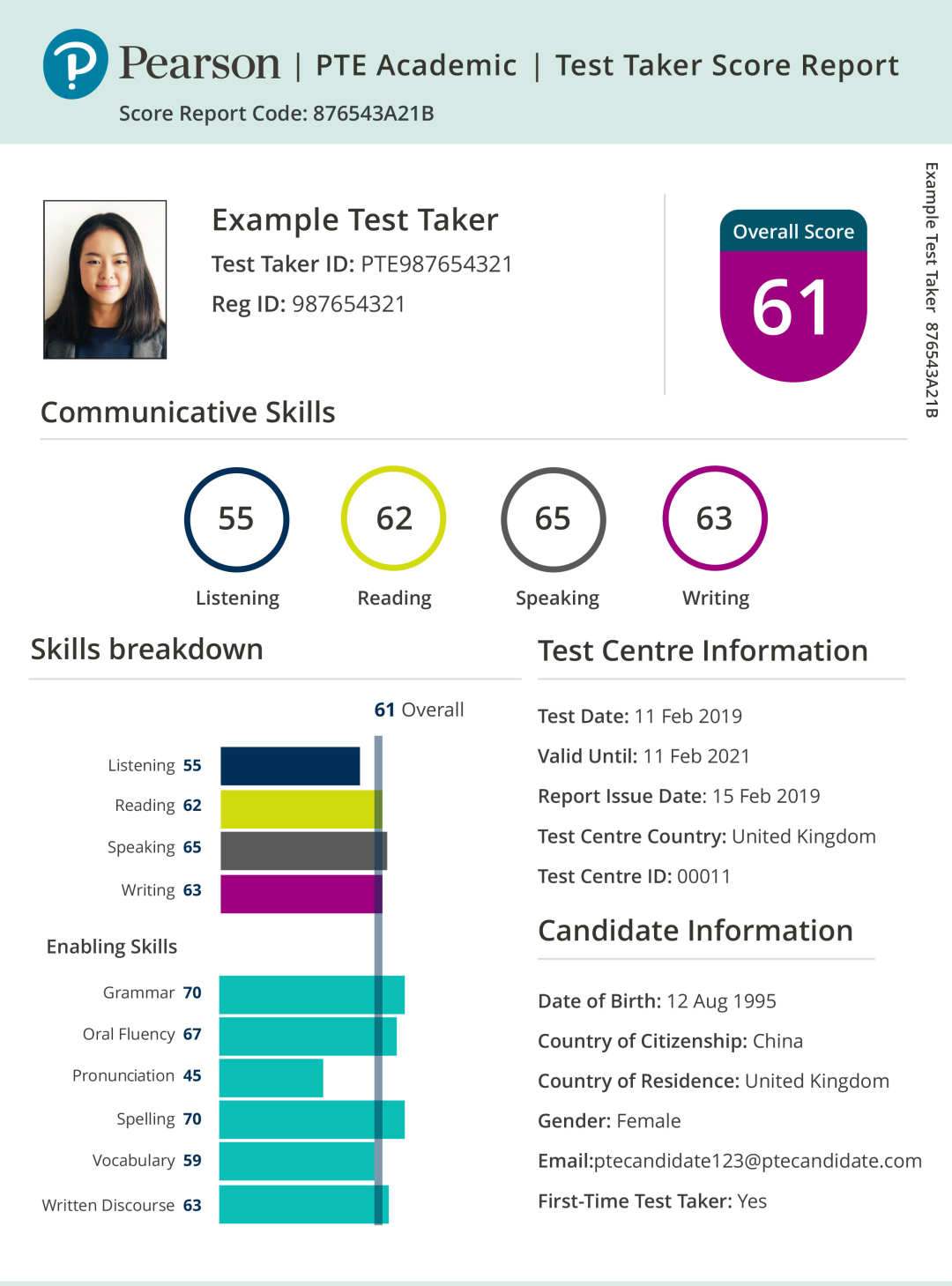
Source: Pearson PTE
The PTE (Pearson Test of English) scores are calculated using an automated scoring system. The calculator will grade on a scale of 0-90 for each section, with some of the tasks earning points only when the answer is correct, whereas others are rated based on a given rubric/standard given to the algorithm (mainly focusing on answer quality, correctness, and formality).
There are two types of scoring in the PTE exam calculator; Partial credit and Correct or Incorrect:
- Partial Credit: Partial credit is only given to correct answers. All incorrect responses will be deducted from points earned by correct ones.
- Correct or Incorrect: One point will be given for every correct answer. Incorrect ones will result in no additional score or deduction.
PTE Academic Types:
The PTE test consists of three parts: Part 1 includes speaking and writing (77-93 minutes), Part 2 covers reading (32-41 minutes), and Part 3 focuses on listening (45-57 minutes). The following sections provide a detailed breakdown of each part's structure, question types, and scoring.
PTE Academic Types Part 1
| QUESTION TYPES | SCORING |
| Read Aloud | Partial credit |
| Repeat Sentence | Partial credit |
| Describe image | Partial credit |
| Re-tell lecture | Partial credit |
| Answer Short Questions | Correct/ Incorrect |
| Summarise Written Text | Partial credit |
| Writing Essay | Partial credit |
PTE Academic Types Part 2
| QUESTION TYPES | SCORING |
| Multiple-choice, choose a single answer | Correct/ Incorrect |
| Multiple-choice, choose multiple answers | Partial credit (for each correct response. Points deducted for incorrect options chosen) |
| Re-order paragraphs | Partial credit (for each correctly ordered, adjacent pair) |
| Reading: Fill in the blanks | Partial credit (for each correctly completed blank) |
| Reading and writing: Fill in the blanks | Partial credit (for each correctly completed blank) |
PTE Academic Types Part 3
| QUESTION TYPES | SCORING |
| Summarise spoken text | Partial credit |
| Multiple-choice, choose multiple answers | Partial credit (for each correct response. Points are deducted for incorrect options chosen |
| Fill in the blanks | Partial credit (each correct word spelled correctly) |
| Highlight correct summary | Correct/ Incorrect |
| Multiple-choice, choose a single answer | Correct/ Incorrect |
| Select missing word | Correct/ incorrect |
| Highlight incorrect words | Partial credit (for each word. Points deducted for incorrect options chosen) |
| Write from dictation | Partial credit (for each word spelled correctly) |
PTE Test Score Descriptions:
The PTE test scores are measured individually on a scale of 10-90, indicating proficiency in specific skill areas. The score ranges, and corresponding descriptions are as follows:
| SCORE RANGE | DESCRIPTION |
| 10-30 |
|
| 31-49 |
|
| 50-64 |
|
| 65-79 |
|
| 80-90 |
|
5. Cambridge Assessment English
Cambridge Assessment English offers a range of English language proficiency tests suitable for high school students. These tests include:
a) Cambridge B2 First Certificate/Cambridge First Certificate (FCE)
The Cambridge B2 test assesses language ability at an upper-intermediate level, evaluating reading, writing, listening, and speaking skills. Universities and employers widely recognise it as a form of qualification to study or work in English language dominated countries.
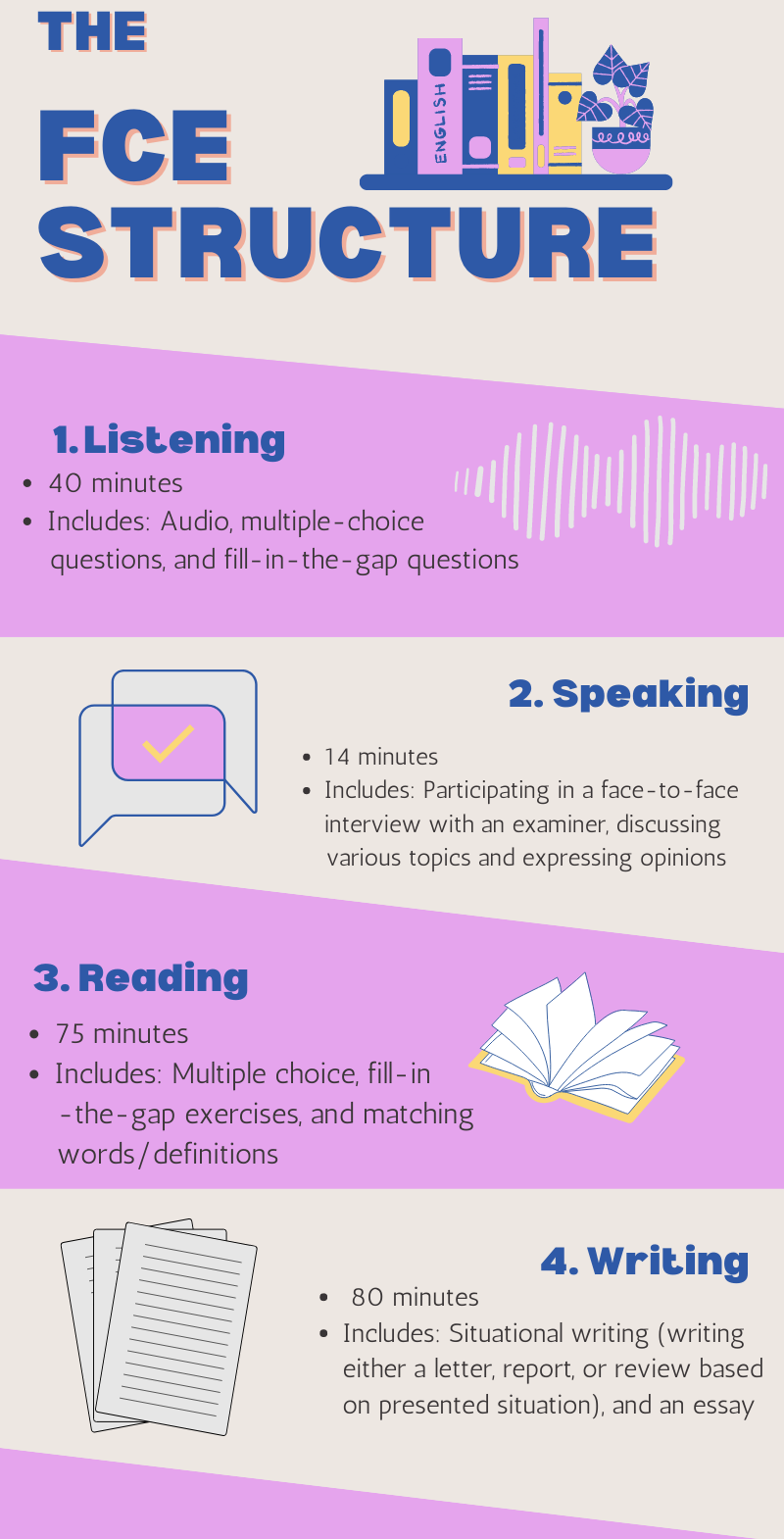
The Cambridge B2 First (FCE) test's scoring system follows a scale ranging from 120 to 190. The total score is based on the performance of all sections within the test. It is highly popular as B2 is often the minimum requirement for university programs in English-speaking countries.
| SCORE RANGE | GRADE | DESCRIPTION |
| 180-190 | A |
|
| 173-179 | B |
|
| 160-172 | C |
|
| 140-159 | B2 |
|
| 120-139 | B1 |
|
The overall score is calculated by adding the scores from each test section. Each section is weighted equally. However, test-takers must achieve a minimum score of 160, with no individual section falling below 140.
It's important to note that the specific score requirements for passing the FCE test or achieving a desired grade may vary depending on the institution or purpose of the test.
The FCE scoring system is designed to accurately assess a test taker's English language proficiency at the upper-intermediate level. The scores are internationally recognised and can be used for various purposes, such as academic admissions and employment opportunities.
b) Cambridge C1 Advanced (CAE)
Cambridge English: Advanced (CAE) is an advanced-level exam that measures proficiency in reading, writing, listening, and speaking. It is suitable for high school students who require a higher level of English for academic or professional purposes.

c) Cambridge English: Proficiency (CPE)
Proficiency (CPE) is the highest-level Cambridge English exam. It demonstrates exceptional language ability, often required for admission to prestigious universities or high-level positions.
It is most suitable for students who are pursuing higher education in English-speaking countries, professionals seeking to enhance their career prospects, or those who simply want to validate their high level of English proficiency.

The Cambridge English Proficiency (CPE) test's scoring system follows a scale ranging from 200 to 230. The total score is based on the performance in all four sections of the test: Reading and Use of English, Writing, Listening, and Speaking.
Here is a breakdown of the scoring system:
| SCORE RANGE | GRADE | LEVEL | DESCRIPTION |
| 220-230 | A | C2 |
|
| 210-219 | B | C2 |
|
| 200-209 | C | C2 |
|
| 180-199 | Level C1 | C1 |
|
| 162-179 | Below level C1 | - |
|
| 0-161 | Not reported | - |
|
The minimum score to pass C2 Proficiency (CPE) is 200 on the Cambridge English Scale. The minimum number of correct items/marks to pass each part is:
- Reading: 28 correct items
- Use of English: 17 correct items
- Writing: 24 marks
- Listening: 18 correct items
- Speaking: 45 marks
CPE Marks Per paper:
Here is a clear explanation of each section and the number of questions and marks assigned in the C2 Proficiency exam.
However, it's important to note that parts are not evaluated separately in the Speaking section, and candidates are awarded marks based on specific criteria.
| READING | ITEMS | MARKS PER ITEM |
| Part 1 | 8 | 1 |
| Part 5 | 6 | 2 |
| Part 6 | 7 | 2 |
| Part 7 | 10 | 1 |
| TOTAL | 31 | 44 |
| USE OF ENGLISH | ITEMS | MARKS PER ITEM |
| Part 2 | 8 | 1 |
| Part 3 | 8 | 1 |
| Part 4 | 6 | 2 |
| TOTAL | 22 | 28 |
| WRITING | ITEMS | MARKS PER ITEM |
| Part 1 | 1 | 20 |
| Part 2 | 1 | 20 |
| TOTAL | 2 | 40 |
| LISTENING | ITEMS | MARKS PER ITEM |
| Part 1 | 6 | 1 |
| Part 2 | 9 | 1 |
| Part 3 | 5 | 1 |
| Part 4 | 10 | 1 |
| TOTAL | 30 | 30 |
| SPEAKING | MAX. POINTS | MARKS PER ITEM |
| Grammatical Resource | 5 | 10 |
| Lexical Resource | 5 | 10 |
| Discourse Management | 5 | 10 |
| Pronunciation | 5 | 10 |
| Interactive Communication | 5 | 10 |
| Global Performance | 5 | 25 |
| TOTAL | 30 | 75 |
Test Fees
*All prices here are in Malaysian Ringgit (RM) and the most recent prices found. The prices for these test types tend to fluctuate, so checking in with an official test centre or authorised registration bodies in Malaysia for the current fees is recommended*
| Test Type | Malaysian Citizen (RM) | Non-Malaysian Citizen (RM) |
| MUET | 150 | 250 |
| IELTS | 795-855 | 795-885 |
| TOEFL | 840-910 | 840-910 |
| PTE | 830-900 | 930-1000 |
| CAE | 1100-1300 | 1300-1500 |
| CPE | 1300-1500 | 1500-1700 |
Conclusion
A strong understanding of the English language is crucial for high school students aiming to pursue higher education or professional opportunities. The English language proficiency tests mentioned in this guide offer reliable measures of language skills and are recognised globally.
By understanding each test's purpose, structure, and content, high school students can decide which test(s) to take based on their goals and aspirations. Engaging in thorough preparation and practice for these tests will give students the confidence and skills needed to excel in their future academic and professional endeavours.
Remember, each test serves a specific purpose, so choosing the test(s) that align with your goals and requirements is essential.
Good luck!
Written by: Julia Tay
Kickstart your education in Malaysia
We'll help you find and apply for your dream university
You might be interested in...
- Sunway University: Malaysia’s Best Cambridge A-Level College with 11 Years of Excellence
- Top Malaysian Universities in QS Asia Rankings 2025
- Sunway University launches New Medical School to transform Healthcare Education
- What to Do After IGCSE/O-Level? Best Study Pathways in Malaysia
- Xiamen University Malaysia Scholarships for International Students in 2025
- Why AI in Education Matters?
- EdUHK Wins Grand Prize at iCAN 2024 Achieves the Best Performance among Hong Kong Universities
- Sunway University Ranked Malaysia's No. 1 Private University in 2025
- A Sunway University Student's Journey from Cerebral Palsy to Graduation
- APU Dominates the 2024 Private Education Excellence Awards with Dual Wins
 +60173309581
+60173309581





